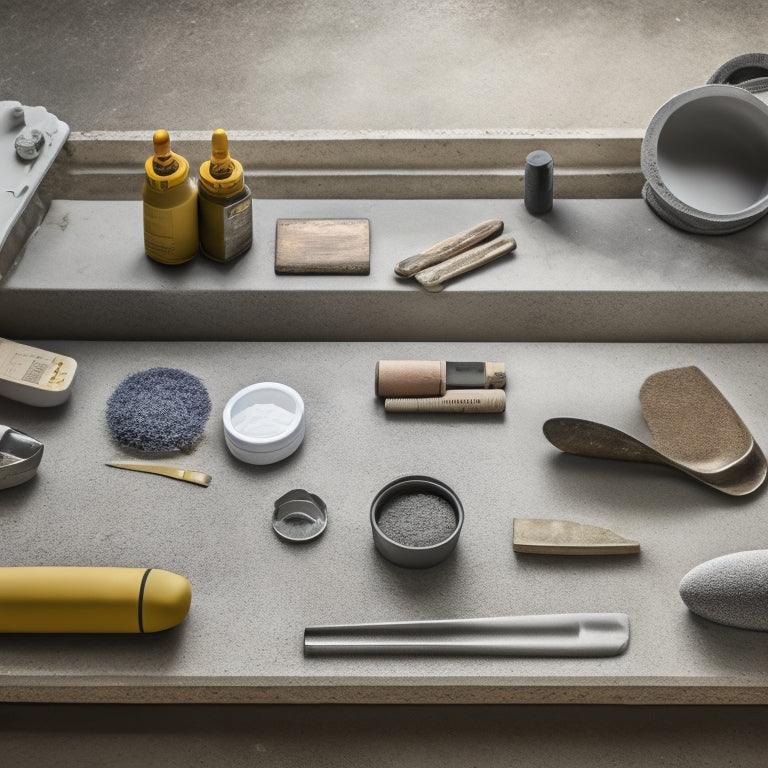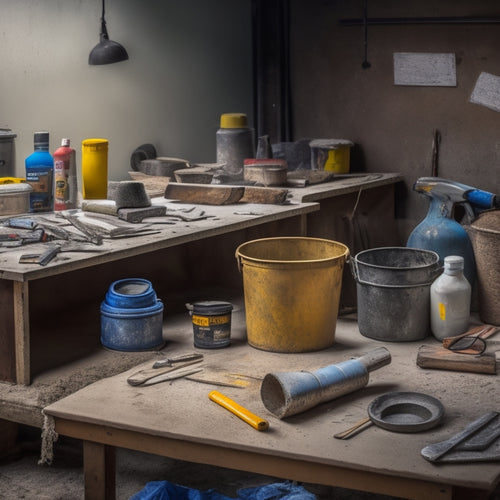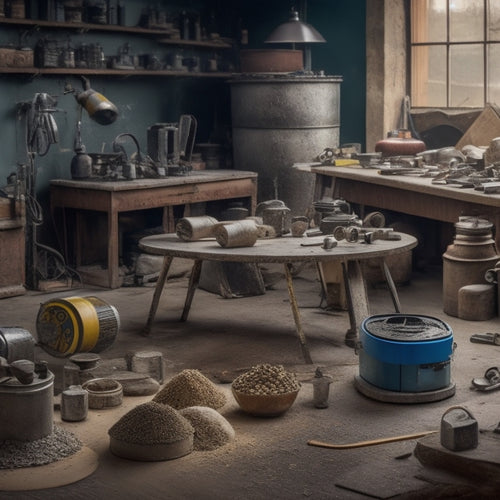
Finishing Tools for a Smooth Concrete Surface
Share
To achieve a smooth concrete surface, you'll require a range of essential tools, starting with hand tools like magnesium or wooden floats, steel trowels, edging tools, and finishing trowels or darbies. Power tools like walk-behind power trowels, concrete grinders, and edging tools will also come into play. Additionally, you'll need edging and corner tools, finishing blades, and concrete scraping and grinding equipment. Polishing and sealing tools, as well as measuring and testing devices, will also be necessary to guarantee the highest quality finish. As you begin to assemble your toolkit, you'll reveal the specific techniques and best practices to access a flawless concrete surface.
Key Takeaways
• A magnesium or wooden float is essential for initial smoothing, followed by a steel trowel for higher smoothness.
• Edging tools, such as edgers or jointers, create defined edges and joints for a professional finish.
• A power trowel or concrete grinder can be used to smooth surfaces, reduce labor time, and enhance finish quality.
• Compaction tools, like tampers, and vibration techniques are crucial for achieving a high-quality concrete finish.
• Finishing blades and accessories, such as steel, stainless steel, or diamond-coated blades, are selected based on the desired surface finish.
Essential Hand Tools for Finishing
Finishing concrete requires a set of essential hand tools that enable you to achieve a smooth, even surface, and having the right ones in your arsenal can make all the difference.
As you begin the finishing process, you'll need a range of tools to execute various smoothing techniques. A magnesium or wooden float is a must-have for initial smoothing, allowing you to remove excess water and create a uniform surface.
Next, a steel trowel comes into play, helping you to refine the surface and achieve a higher level of smoothness. Edging tools, such as an edger or a jointer, are also vital for creating clean, defined edges and joints.
Additionally, a finishing trowel or a darby will help you to further refine the surface, removing any imperfections and achieving a high-gloss finish.
Mastering these finishing techniques requires practice, but with the right hand tools, you'll be well on your way to producing a professional-grade finish. By investing in these essential tools, you'll be able to execute a range of smoothing techniques that will elevate your concrete finishing skills.
Power Tools for Smoothing Concrete
You'll take your concrete smoothing to the next level with the help of power tools, which can greatly reduce labor time and effort while producing a higher-quality finish.
With the right power tools, you'll be able to achieve a smoother, more even surface that's perfect for applying finishes or coatings.
When it comes to concrete smoothing techniques, power tools are essential for surface preparation. A walk-behind power trowel is a versatile tool that can be used for both new and existing concrete surfaces. It's ideal for large areas and can be equipped with various blades and attachments to suit your specific needs.
Another useful tool is a concrete grinder, which is designed for heavy-duty surface preparation. It's perfect for removing old coatings, grinding down high spots, and smoothing out rough surfaces.
Edging and Corner Tools Needed
As you focus on achieving a professional finish, you'll need to create clean edges and precise corners that showcase your concrete work.
To accomplish this, you'll require specialized tools designed for edging and corner forming.
Clean Edge Creations
Clean Edge Creations
With precision and control, edging and corner tools enable you to create clean, defined edges and corners that elevate the aesthetic appeal of your concrete creations. To achieve a professional finish, you'll need the right tools for the job. When it comes to clean edge techniques, having the correct edge finishing materials is essential.
| Tool | Purpose |
|---|---|
| Edger | Creates a clean, defined edge |
| Corner Trowel | Finishes corners with precision |
| Edge Float | Smoothes and flattens edges |
| Edge Rake | Removes excess concrete and debris |
When selecting edge finishing materials, consider the type of concrete you're working with, as well as the desired finish. For example, a steel edger is ideal for creating sharp, clean edges, while a rubber edger is better suited for curved or irregular edges. By mastering clean edge techniques and using the right tools, you'll be able to achieve a smooth, professional finish that showcases your concrete creations at their best.
Precise Corner Forming
Forming precise corners requires careful attention to detail and the right tools, building on the clean edges you've created to add an extra layer of sophistication to your concrete designs.
You'll need to employ corner formwork techniques that guarantee crisp, sharp corners that complement your overall design.
Here are three essential tools you'll need to get it right:
-
Corner trowels: These specialized trowels are designed to reach into tight spaces and form precise angles. They're typically smaller and more agile than standard trowels, making them ideal for corner work.
-
Corner edgers: These tools help you create a clean, defined edge where the wall meets the floor or ceiling. They come in various shapes and sizes to accommodate different corner types.
-
Corner finishing tools: These tools, such as corner floats and corner scrapers, help refine the corner's shape and smooth out any imperfections. They're vital for achieving a professional-looking finish.
Tamping and Compacting Equipment
When it comes to achieving a smooth, even finish, you'll need to master the art of tamping and compacting concrete.
To do this, you'll need to select the right tamper for the job, understand the different compaction methods, and learn effective vibration techniques to remove air pockets and excess water.
Proper Tamper Selection
You'll need to select the right tamper for the job, as the type and size of your tamper will greatly impact the quality of your concrete finish. The tamper you choose will affect the efficiency of your tamping techniques and ultimately, the smoothness of your concrete surface.
When selecting a tamper, consider the following key factors:
-
Tamper materials: Tampers can be made from steel, aluminum, or wood, each with its own strengths and weaknesses. Steel tampers are durable and suitable for heavy-duty use, while aluminum tampers are lighter and ideal for smaller projects. Wooden tampers are often used for decorative or specialty finishes.
-
Tamper size: The size of your tamper will depend on the scale of your project. Larger tampers are better suited for large areas, while smaller ones are more effective for smaller spaces or detailed work.
-
Tamper head design: The design of the tamper head can greatly impact the quality of your finish. Look for tampers with a flat, rectangular head for general-purpose use, or a rounded head for more intricate work.
Compaction Methods Explained
Effective compaction methods are crucial to achieving a high-quality concrete finish, and selecting the right tamping and compacting equipment is fundamental to getting the job done efficiently and accurately.
As you prepare to compact your concrete, you'll need to take into account the specific compaction techniques required for your project. This involves understanding the type of concrete you're working with, as well as the soil conditions beneath it. For instance, if you're dealing with unstable soil, you may need to employ soil stabilization methods to guarantee a solid foundation.
When it comes to tamping and compacting equipment, you'll have a range of options to choose from. Plate compactors, for example, are ideal for compacting large areas, while handheld tampers are better suited for smaller, more precise jobs.
You may also need to take into account the weight and size of your equipment, as well as its ability to apply the necessary pressure to achieve the best compaction. By selecting the right equipment and employing the correct compaction techniques, you'll be able to achieve a smooth, even finish that meets your project's requirements.
Effective Vibration Techniques
By applying the right vibration techniques with your tamping and compacting equipment, you can assure that air pockets are eliminated, and the concrete is densely packed to achieve a strong, durable finish. This is essential in guaranteeing surface consistency, as uneven concrete can lead to cracks and other defects.
To achieve ideal results, you should:
-
Adjust the vibration frequency according to the concrete's slump and mix design. A higher frequency is typically required for stiffer mixes, while lower frequencies are better suited for more fluid mixes.
-
Maintain consistent vibration amplitude to guarantee uniform compaction. This can be achieved by adjusting the equipment's speed and pressure accordingly.
-
Monitor the concrete's surface regularly to identify any areas that require additional vibration. This will help you achieve a smooth, even finish and prevent defects.
Finishing Blades and Accessories
As you move on to the final stages of concrete finishing, selecting the right finishing blades and accessories becomes essential for achieving a high-quality, smooth surface. The type of blade you choose will directly impact the finish you achieve. You'll want to evaluate the blade material, as well as the finishing techniques you'll be using.
| Blade Material | Finishing Technique | Surface Finish |
|---|---|---|
| Steel | Floating and tamping | Medium to high gloss |
| Stainless Steel | Power troweling | High gloss |
| Carbide-tipped | Edging and jointing | Low to medium gloss |
| Diamond-coated | Grinding and polishing | High gloss |
When it comes to blade materials, steel and stainless steel blades are suitable for most finishing techniques, while carbide-tipped blades are better suited for edging and jointing. Diamond-coated blades, on the other hand, are ideal for grinding and polishing. By selecting the right blade material and finishing technique, you'll be able to achieve a smooth, high-quality surface that meets your project's requirements.
Concrete Scraping and Grinding
You'll need to switch to more aggressive tools, like scrapers and grinders, to remove imperfections and prepare the concrete surface for final finishing. These tools are essential for concrete surface preparation and will help you achieve a smooth, even texture.
When scraping, you'll use a series of increasingly finer blades to remove rough patches, old adhesives, and other imperfections. This process can be labor-intensive, but it's vital for ensuring a strong bond between the concrete and any subsequent coatings or finishes.
Here are three key considerations to keep in mind when scraping and grinding:
-
Choose the right blade: Select a blade that's appropriate for the type of concrete you're working with and the level of imperfections you need to remove.
-
Work progressively: Start with coarse blades and gradually move to finer ones to avoid scratching the surface.
-
Keep the surface clean: Regularly vacuum or sweep the area to prevent debris from interfering with the scraping and grinding process.
Polishing and Sealing Tools
With the surface prepared, you can now move on to the final stages of concrete finishing, where polishing and sealing tools come into play to enhance the appearance and durability of the concrete.
At this stage, you'll employ polishing techniques to refine the surface, removing any imperfections and achieving a high-gloss finish. This is typically done using progressively finer abrasives, such as diamond polishing pads or resin-bonded disks, which are designed to cut and polish the concrete simultaneously.
Once you've achieved the desired level of polish, it's time to apply a sealant to protect the concrete from stains, spills, and wear. Sealing methods can vary depending on the type of concrete and the desired level of protection, but common options include topical sealers, penetrating sealers, and epoxy coatings.
When choosing a sealant, consider factors such as durability, UV resistance, and slip resistance to guarantee the concrete surface meets your performance requirements.
Measuring and Testing Devices
Two essential tools in your concrete finishing arsenal are measuring and testing devices, which enable you to accurately assess the concrete's properties and guarantee it meets the required specifications. These devices help you evaluate the concrete's strength, density, and other crucial characteristics, making certain that your finished product meets the project's testing standards.
Here are three critical measuring and testing devices you should have in your toolkit:
-
Concrete density meters: These devices use ultrasonic or gamma-ray technology to measure the density of the concrete, helping you identify potential issues with the mix design or curing process.
-
Slump meters: These tools measure the concrete's workability and consistency, allowing you to adjust the mix design or finishing techniques accordingly.
-
Strength testing equipment: This includes devices like compression testing machines, which help you determine the concrete's compressive strength and guarantee it meets the required specifications.
Frequently Asked Questions
Can I Use a Single Tool for Both Rough and Smooth Finishing?
You're wondering if one tool can handle both rough and smooth finishing tasks. The answer is yes, with versatile tools that adapt to various finishing techniques, allowing you to switch between aggressive removal and fine-tuning with ease.
How Do I Prevent Tool Marks on the Concrete Surface?
To prevent tool marks, you'll want to focus on proper tool selection and surface preparation; guarantee your tools are in good condition, and the concrete is clean, dry, and even, allowing for a smooth, mark-free finish.
What Is the Ideal Temperature for Finishing Concrete?
'You're likely aware that 75% of concrete placements occur in temperatures between 50°F and 80°F. For ideal finishing, aim for a concrete temperature between 60°F and 70°F, as this range minimizes temperature-related defects and allows for effective comparison of finishing techniques.'
Can I Finish Concrete in Direct Sunlight or Extreme Weather?
You shouldn't finish concrete in direct sunlight or extreme weather, as it can cause uneven curing, cracking, and discoloration due to intense sunlight effects and unpredictable weather considerations that affect concrete's hydration and setting process.
How Do I Clean and Maintain My Concrete Finishing Tools?
You'll want to clean and maintain your concrete finishing tools regularly, particularly after each use. For metal tools, use a wire brush and mild detergent, while for resin or rubber tools, opt for a soft-bristled brush and gentle soap.
Conclusion
As you put the final touches on your concrete surface, remember that a smooth finish is like a work of art - it requires precision, patience, and the right tools.
With the arsenal of finishing tools at your disposal, you'll be able to craft a surface that's as smooth as glass.
From edging and compacting to polishing and sealing, each tool plays an essential role in creating a masterpiece that will stand the test of time.
Related Posts
-

3 Best Tools to Buy for Concrete Repair Online
When buying tools for concrete repair online, you'll want to research multiple retailer options to find the best prod...
-

Top DIY Concrete Grinding and Polishing Tools
When selecting DIY concrete grinding and polishing tools, you'll want to take into account a range of factors to guar...
-

What Tools Are Needed for Concrete Wall Foundations
You'll need a thorough array of tools and equipment to construct a concrete wall foundation that meets structural int...


